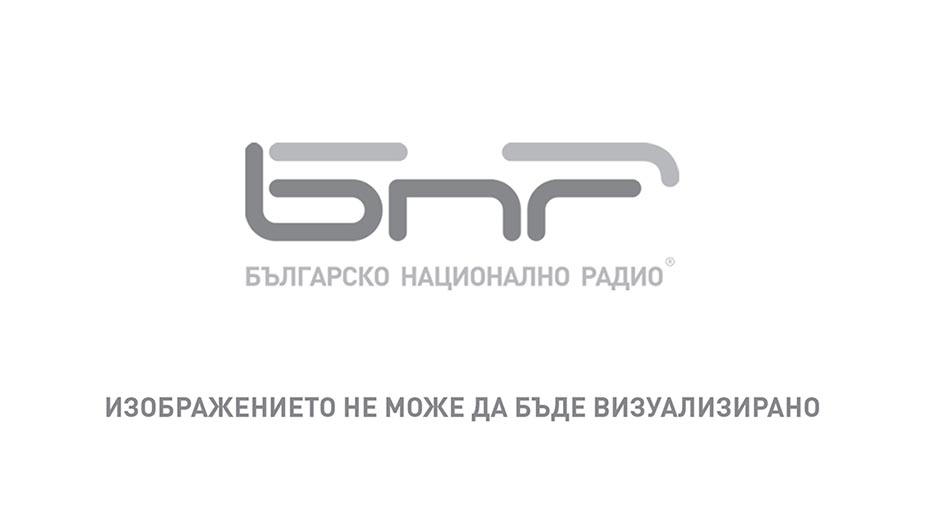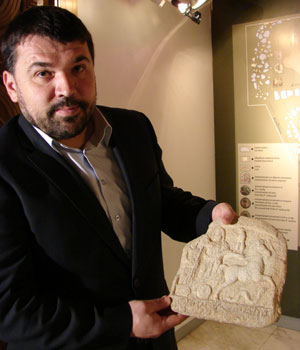 3
3
The team of Associate Prof. Ivan Hristov, deputy director of the National Museum of History has been researching a Thracian residence of a ruler at Kozi Gramadi peak in the Sredna Gora Mountain. In the autumn of 2013 the archaeologists discovered numerous artifacts in a sanctuary of Zeus and Hera – the 4th known so far in Bulgarian lands. Competing with bad weather and treasure hunters they excavated the place and over 100 rite stone tiles that the ancient ones had sacrificed to gods were brought to the museum. The best preserved among those have already been displayed at the Antiquity Hall with the NMH. Other artifacts have been discovered at the 1361 m high peak, over 300 coins from the 4th c. BC – 5 c. AD, ceramic vessels and lamps among those.
 “We are talking about a cult spot from the Roman époque with its pre-history existing across the entire 1st millennium BC,” Ivan Hristov says. “This is one of the richest sanctuaries of Zeus and Hera in the number of objects discovered. There are lots of other sanctuaries in Bulgaria, but luckily this one has been totally researched due to the funding of the cultural ministry. We got the job done right before the first snowfall. We have a unique sanctuary there, spreading on 1 ha and surrounded by a massive stone wall. Imagine an old antiquity monastery that functioned from the 8th c. BC to the early Christian époque. It is a peak with lots of history and religion, related to the Odrysian king’s residency. The spot was a major center for the Thracian tribe back then. I am about to analyze things there, along with my colleagues, experts in Thracology, but I am glad I have the chance to publish the results in a book.”
“We are talking about a cult spot from the Roman époque with its pre-history existing across the entire 1st millennium BC,” Ivan Hristov says. “This is one of the richest sanctuaries of Zeus and Hera in the number of objects discovered. There are lots of other sanctuaries in Bulgaria, but luckily this one has been totally researched due to the funding of the cultural ministry. We got the job done right before the first snowfall. We have a unique sanctuary there, spreading on 1 ha and surrounded by a massive stone wall. Imagine an old antiquity monastery that functioned from the 8th c. BC to the early Christian époque. It is a peak with lots of history and religion, related to the Odrysian king’s residency. The spot was a major center for the Thracian tribe back then. I am about to analyze things there, along with my colleagues, experts in Thracology, but I am glad I have the chance to publish the results in a book.”
Taking Radio Bulgaria's question, Associate Prof. Hristov said that the place was relatively well preserved, since treasure hunters found it difficult to reach it.
“Thank God, we managed to draw the attention of the interior ministry and the special services to the spot after 2005 and those secured the area. There were, of course, attacks of treasure hunters, just like in any other archaeological site in Bulgaria, but we got really lucky. We took out whole or fragmented rite tiles and coins from underneath the paths we had walked on years before 2013. Those are now in the museum, which means a victory over treasure hunters.As far as the coins discovered are concerned, those will be cleaned up and exhibited behind a separate window. According to Ivan Hristov one can spot an incredible variety on the stone tiles. “We see a mythological story here, which is very complicated, because we see mixed typically Greek depictions – Zeus and Hera, combined with Thracian elements. Some of the inscriptions prompt their owners were Thracians and Greeks, or a mixed population that used to walk the long way to the sanctuary in the mountain with the idea to pay its homage to the gods.”
One curious detail – at the discovery of the first better preserved ritual tiles, three birds appeared above the heads of the archaeologists – a pair of eagles with their offspring. Those were circling in the area throughout the entire expedition. “We all know that the eagle is the symbol of Zeus. Perhaps that was a sign we had the blessing of gods to do our job before the snowfall,” Associate Prof. Ivan Hristov says in conclusion.
English version: Zhivko Stanchev
From 23 to 28 September, Sofia and Vidin will host the 7th International Conference on the Roman Danubian Provinces on the theme "Frontier Landscapes along the Danube", reports BNR Vidin. The initiative was taken by the University of Ferrara, Italy...
The independence of Bulgaria was proclaimed on 22 September, 1908. After the most audacious independent act in Bulgarian history – the unification of Eastern Rumelia with the Principality of Bulgaria – Bulgarians once again demonstrated the power of..
Bulgarian archaeologists have discovered a second statue in the large sewage channel of the ancient city of Heraclea Sintica. Around 11 a.m. on September 20, the team led by Professor Dr. Lyudmil Vagalinski came across another marble sculpture near..
There are three special days on the calendar of the Bulgarian Orthodox church, on which believers pray to God and give alms to honour the memory of..
Volunteers joined the efforts to clean and restore the monastery St. Spas near Bakadzhik peak. The campaign is being organized on 2 November by Stoimen..

+359 2 9336 661
